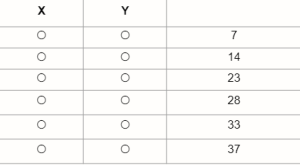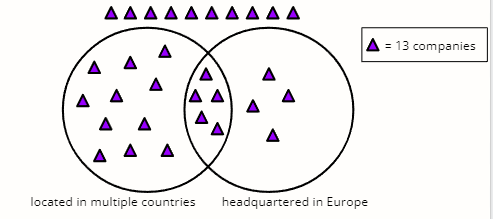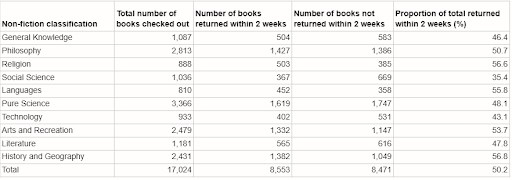The Integrated Reasoning section of the Executive Assessment (EA) is all about synthesizing and analyzing data from multiple sources, a skill highly valued in executive roles. IR utilizes fundamental skills from both the quantitative and verbal reasoning sections (hence, integrated). Unlike the quant and verbal sections, however, which have their basis inspecific math and language abilities, the Integrated Reasoning (IR) section tests your capacity to manage complex information, prioritize relevant details, and make reasoned decisions.
The IR section has become a favorite among business schools because it mimics the real-world tasks professionals encounter in data-driven roles. Moreover, studies from the first several years that IR was offered indicate that, as a section, it is strongly predictive of academic success in an MBA or graduate management program.
Executive Assessment Integrated Reasoning Section Overview
The Integrated Reasoning section is one of the three sections on the EA exam, and it is scored from 0 to 20. To succeed in this section, you’ll need a combination of quantitative, verbal, and analytic skills operating in tandem, in order to address the complicated questions put to you. The questions require you to interpret charts and tables, collate and manage data, understand systems, extract insights, and make well-informed decisions based on data.
This guide covers everything you need to know about the EA Integrated Reasoning section, from question types to effective preparation strategies. Each question type also links to an article with a more in depth overview, so that when you’re ready you can drill down into the nitty gritty of the IR.
Types of Questions in EA Integrated Reasoning
The EA Integrated Reasoning section is divided into four main question types: Graphics Interpretation, Table Analysis, Two-Part Analysis, and Multi-Source Reasoning. Each category tests your ability to handle and interpret complex information in distinct formats, assessing your skills in data analysis, logical reasoning, and decision-making. Simply understanding the question types and how they modulate complexity is excellent preparation for your mind to then focus on solving in a clearer and more efficient manner.
Key Highlights:
- Number of Problems: 12 – each with 2-3 questions
- Time: 30 minutes
- Time per Problem: 2 ½ minutes
- Question Types: Graphics Interpretation, Table Analysis, Two-Part Analysis, and Multi-Source Reasoning.
- Score Range: 0 to 20 for each section (Integrated Reasoning as well as Quant and Verbal). Most scores fall between 7-14.
- IR Weight: The IR section represents a third of your total EA score, making it a significant component of the overall EA exam.
The section consists of 12 questions, and you have 30 minutes to complete them, averaging about 2.5 minutes per question. These questions are presented in two modules of 6 questions each, though they’re timed together and you won’t notice the transition between them. Based on your performance in the first module, the difficulty level of the questions in the second module adapts to your skill level. Answering more complex questions accurately in the first module leads to a higher difficulty level in the second, maximizing your potential score.
Types of Questions in EA Integrated Reasoning
Two-Part Analysis
Two-Part Analysis questions present an interdependent system, along with a table of answers with two columns, each corresponding to a different question. To complete the problem you’ll need to select one answer for each column/question. The key is that the answers are related to one another. Your task is not to answer each question individually, but to understand the underlying system to address both the questions in tandem. You’ll need to integrate information and determine the relationship between different variables to select the correct answers for both parts. This question type evaluates your ability to approach multi-dimensional problems with flexibility and logical rigor.
Example:
Consider the sets S, T and U, where
S = {35, 14, 64, 23, 49, 67}
T = {x, 35, 14, 64, 23, 49, 67} and
U = {y, 35, 14, 64, 23, 49, 67}
The mean of T is 5 less than the mean of S. The median of U is 9 less than the median of S.
Select the value of x and the value of y consistent with the statements given. Make two selections, one in each column.
Graphics Interpretation
Graphics Interpretation questions require you to interpret visual data presented in common formats such as bar charts, line graphs, or pie charts, but often with a creative twist. Other times you’ll be presented a graphic that is entirely new, and your task will be to interpret how it works in order to answer the questions provided. You’ll be asked to analyze these visuals, extract insights, and draw conclusions based on the graphical data. While there is always enough information and the graphics are never ambiguous, it can still be challenging to decipher how a graphic “works”, and therein lies the challenge. Professionals often have a elg up on this problem type, as this is a skill critical for handling data reports and presentations in the workplace, particularly in advanced analytics and data roles.
Example:

Refer to the pictograph of a survey of attendees at the annual meeting of an international hotels group. Each symbol represents 13 companies in a sample of 390. Use the drop-down menus to complete each statement according to the information presented in the diagram. If one company is selected at random from the 390 surveyed, the chance that the company will be located in only one nation or headquartered outside of Europe or both is _____
A: 1 out of 6
B: 1 out of 3
C: 2 out of 3
D: 5 out of 6
If one company is selected at random from the 390 surveyed, the chance that the company will be both located in a single country and headquartered outside of Europe is _____
A: 1 out of 6
B: 1 out of 3
C: 2 out of 3
D: 5 out of 6
Table Analysis
Table Analysis questions involve data in a table format with various columns and rows, often presenting information on multiple variables at the same time. A key feature of these tables is that they’re sortable by columns, meaning you can rapidly organize the data to draw out the information that you’re seeking. These questions challenge you to determine whether specific statements about the data are accurate or inaccurate. Success withthis question type hinges on identifying relevant information while filtering out unnecessary data—a skill that mirrors real-world tasks involving spreadsheets and tabular data.
Example:
For each of the following statements, select Yes if the statement is true based solely on the information in the table; otherwise select No.

The table shows circulation data, by non-fiction classification, for books in a certain library system in November 2003. Percentages are given to the nearest 0.1 percent.

Multi-Source Reasoning
Multi-Source Reasoning probems representthe most complex type of IR problem, as they require analyzing information from multiple tabs or sources, and answering several questions utilizing the information presented. Each tab might contain any of the following: text, data tables, charts, or a combination thereof, and you’ll need to navigate between these sources to answer the questions. A key feature of this problem type is that the essential information is distributed among the different data sources (like a relational database), requiring you to navigate a “chain of information” to address the questions asked. Multi-Source Reasoning evaluates your skill in managing and synthesizing diverse information—a critical skill for executives handling multi-faceted business data.Mastering each question type requires strong data interpretation and analytical skills, combined with an ability to quickly adapt to different informational formats.
Example:
Definition of musician: Any person who uses a device created to produce sound through blowing air, vibrating a string, striking a surface, or electronic means, or uses parts of their own body, with the intent of creating sound for the purpose of entertainment, communication, self-improvement, education, or production of an emotional response. This definition of musician fails to capture the standard concept of a musician in that it allows for the inclusion of some things that are not ordinarily thought of as musicians, for example, people who _____,
A: play many instruments
B: perform their music as a paid profession
C: turn on a stereo for their own enjoyment
D: write music for the purpose of others performing it
E: work as piano movers
F: teach the history of music
and excludes some things that are ordinarily thought of as musicians, for example, people who _____.
A: play many instruments
B: perform their music as a paid profession
C: turn on a stereo for their own enjoyment
D: write music for the purpose of others performing it
E: work as piano movers
F: teach the history of music
Tips for EA Integrated Reasoning Prep
The EA Integrated Reasoning (IR) section demands more than just basic data analysis; your focus should be on synthesizing information from multiple sources quickly and accurately, while always maintaining a “big picture” perspective. Our head instructor Mike emphasizes that success in the IR section hinges on the ability to prioritize relevant data, recognize logical relationships, and manage complex information without getting bogged down in irrelevant details. Below, you’ll find some essential strategies to help you master the IR section:
Focus on Managing, Not Processing, Information
In the IR section, the goal isn’t to analyze every bit of data, but to know how to effectively access and use information under a time constraint. Each question type is designed with an “overflow” of data, meaning only some of it is relevant to the question at hand. Successful candidates learn to find the “needle in the haystack”—the specific data points that answer the question without sifting through every piece of information. Practicing this skill is crucial; it mirrors real-world scenarios where you often have too much data and limited time to find what matters. More often than not, asking the right question of the data is what drives success on IR.
Tip: As you practice, ask yourself: “What information is truly relevant here?” Train yourself to recognize cues in the question that guide you toward the data you require and ignore what’s extraneous.
Master the Art of Data Triage
IR questions are similar to real-world problem-solving, where you’re not given facts in the traditional order. This section challenges you to prioritize what’s critical and to reorganize information for efficiency. For example, Data Sufficiency questions flip the typical flow—you’re given propositions before facts, a structure that forces you to approach data differently. Learning to triage data in this way requires a disciplined approach, where you think critically about the order and hierarchy of information.
Tip: Practice reversing your typical thought process and become more proactive in determining your framing. For example, a question like “4 + __ = 7”, is effectively the same as “7 – 4 = __”, yet is meaningfully less complex. If you don’t believe it, think about the multi year gap where the easier question was fully accessible (from 2nd grade/Year 2 for most people), whereas the other didn’t come online until middle school. These questions, simple as they may seem, train you to adapt your approach. This shift in thinking becomes invaluable when handling complex data sets in IR questions and extends to the real world.
Develop Flexible Analytical Skills
IR questions require more flexibility than traditional quant or verbal questions. Instead of using a single method, focus on adapting to different formats and switching strategies, what we here at Apex call Solution Paths, on the fly. Integrated Reasoning draws on quantitative, verbal, and logical skills simultaneously, so practice agility in your approach, switching from numbers to narrative to visual data as required.
Tip: Mix up your practice by working with different question types back-to-back. This will train you to handle varied formats without a mental reset, helping you developthe flexibility needed to addressthe IR section’s demands.
Practice Prioritizing Data within Graphs and Tables
In Graphics Interpretation and Table Analysis questions, it’s easy to becomeoverwhelmed by dense visuals and rows upon rows of numbers. The key is to prioritize the essential data points and make quick, logical connections between them. Rather than reading through every single line, use strategic skimming to find trends, anomalies, or specific figures that the question is likely targeting. Very often something as simple as finding the largest/smallest number is the key to organizing the entire ream of data.
Tip: In practice, approach graphs and tables with specific questions in mind, like “What’s the main trend here?” or “Is there an outlier I can find?” This helps you filter out less relevant information and zero in on the insights the questions are seeking.
Stay Objective with Multi-Source Reasoning
Multi-Source Reasoning questions require you to jump between tabs of data, and it’s easy to make assumptions if you’re not careful. Mike emphasizes that this question type is a test of objectivity—staying focused on what’s presented rather than what you might assume, for ease or out of habit. Multi-Source Reasoning questions often include distractors or conflicting data points, so approach each source independently before synthesizing across them.
Tip: Break down each source in isolation, noting key points without cross-referencing other tabs too soon. This “separate then integrate” approach ensures that you avoid making incorrect assumptions based on incomplete data.
Build Your Strategy Around Decision-Making Under Pressure
Integrated Reasoning is ultimately designed to test how well you handle information overload under time pressure. Instead of aiming for perfection on each question, focus on making informed, efficient decisions at the problem level. Mike suggests that you think of each problem as a whole, making a “snapshot decision” as to whether to engage with it—remember that if you don’t answer every question on a particular problem correctly, you won’t receive any credit!. Given the short time frame, it’s ok to intentionally skip one or two problems in order to have time for the rest.
Tip: Set time benchmarks as you practice, aiming to answer each question within 2.5 minutes. This keeps you from getting stuck on any one problem, building your ability to make quick, data-driven decisions without second-guessing.
Ace the EA Integrated Reasoning with Expert Tutoring
The IR section isn’t just about solving problems; it’s about how effectively you can manage information, filter out irrelevant data, and make smart decisions on the spot. Each skill you build here translates directly to real-world data handling, making it one of the most practical aspects of EA prep. Working with an expert tutor can help you refine these skills, providing targeted strategies and personalized feedback.
